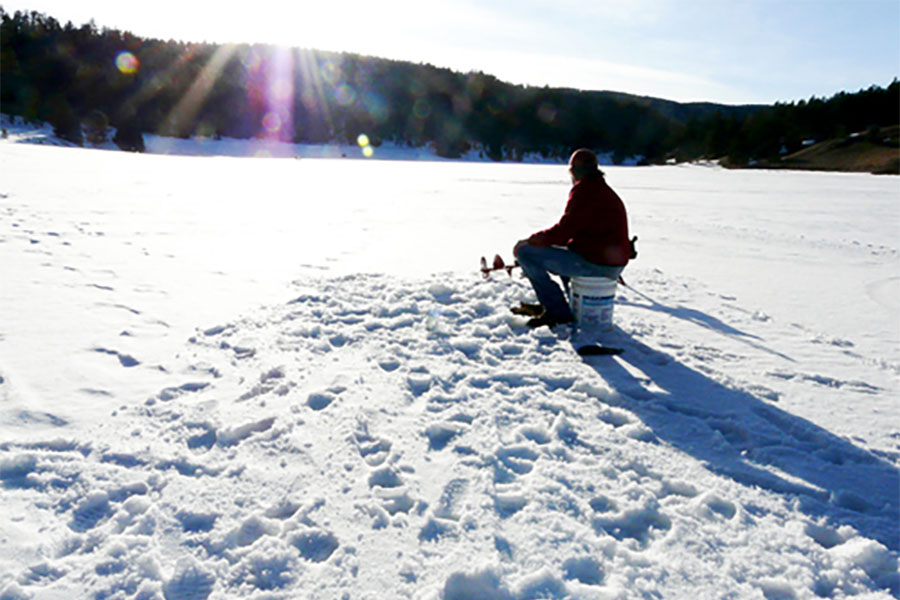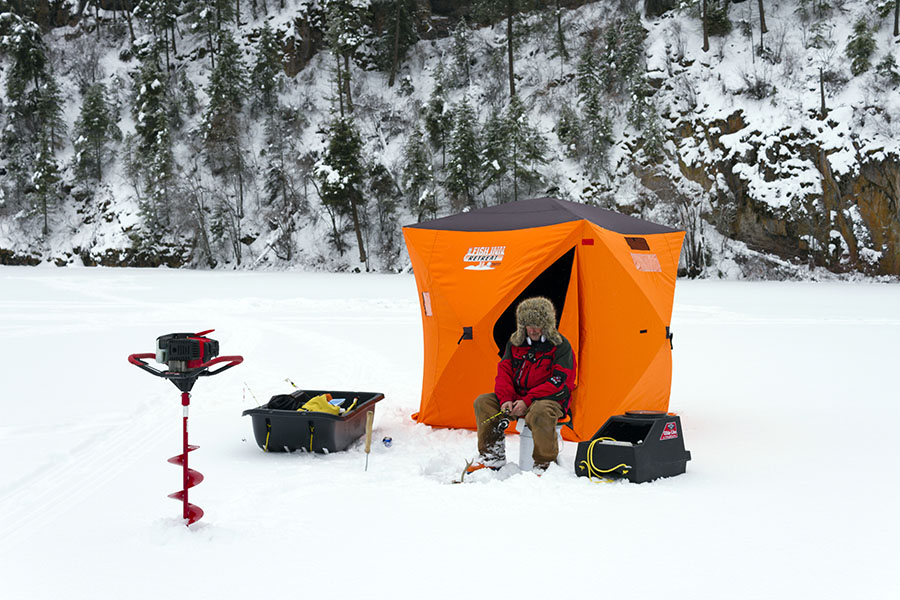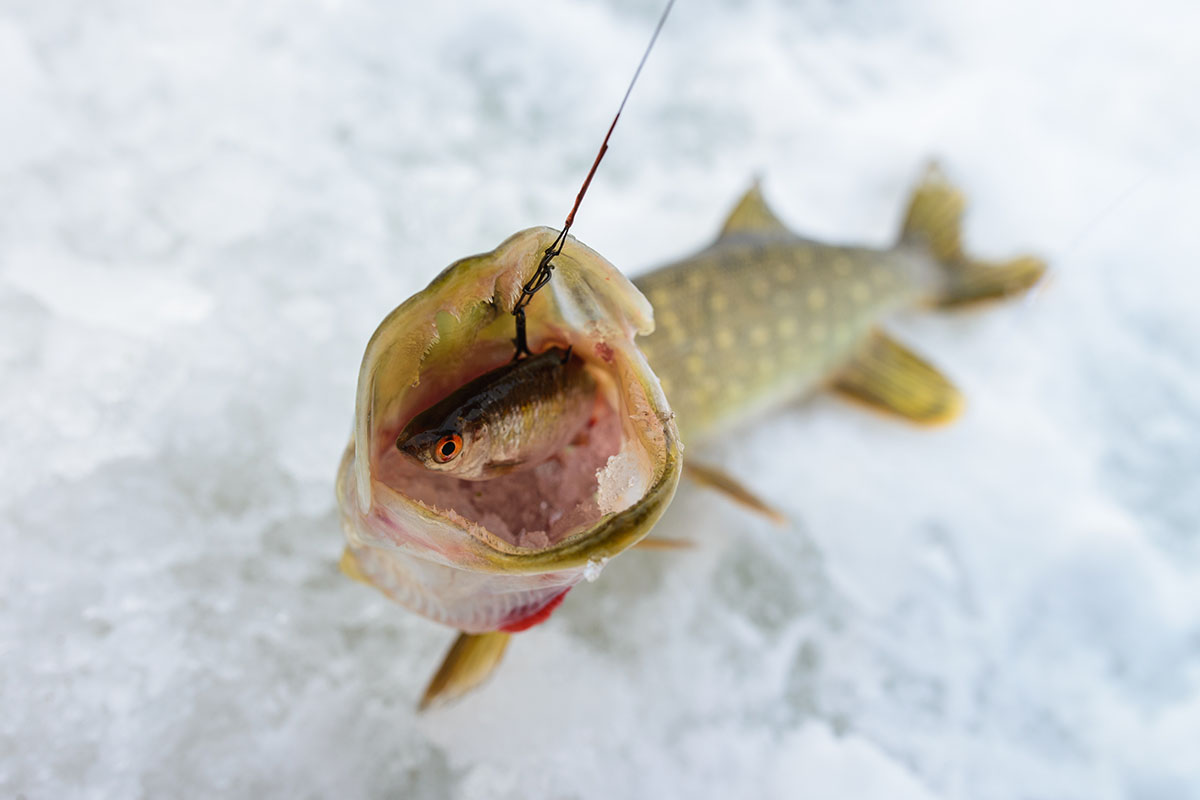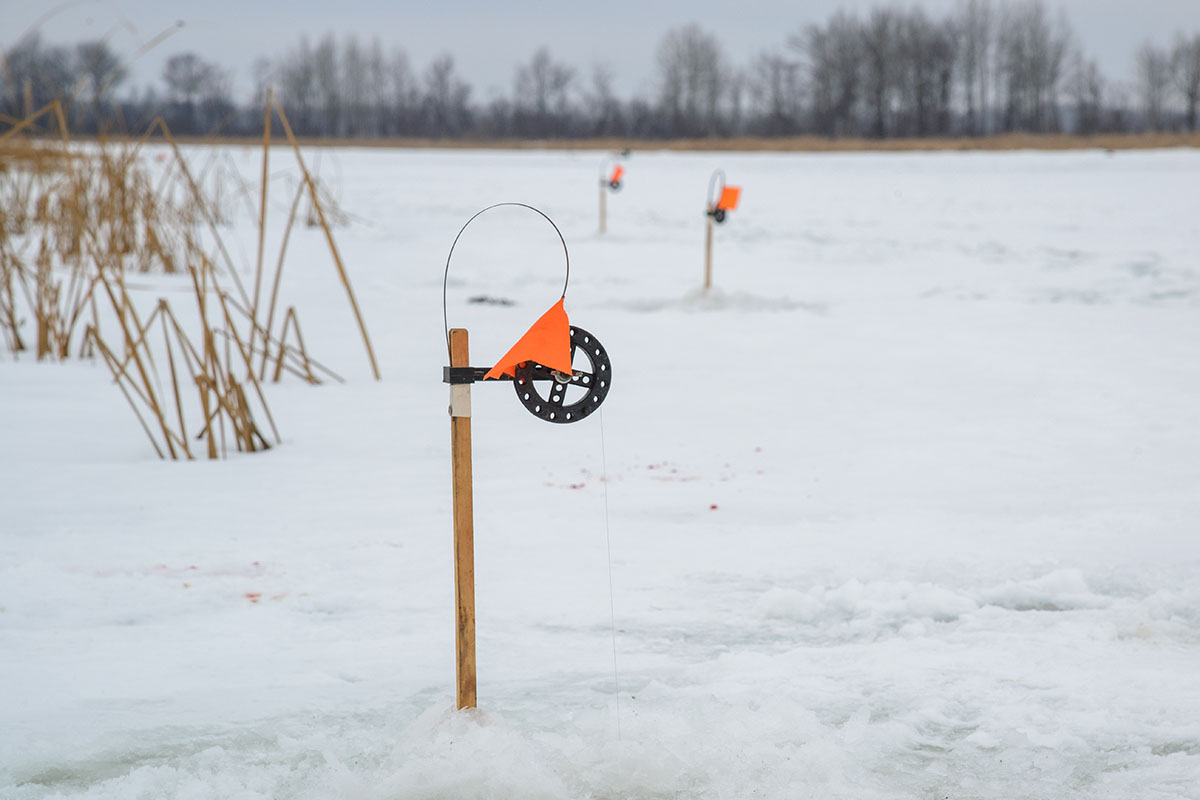The Northern Pike is one of the few species of game fish that will rouse me from my warm bed at the first light of sun to spend hours sitting on a frozen lake in the dead of winter. I love ice fishing for pike. Big, aggressive, and a ton of fun to catch, the Northern Pike is the apex predator for most of the frozen lakes in the U.S. and Canada. Targeting these toothy predators requires knowing their habits, when they’re feeding, and the appropriate fishing tackle. With this guide, I will break down all these points to give you the best chances of landing that trophy Northern through the ice.
The Target: Northern Pike
Waiting silently at the edge of the underwater grass flat, the Northern Pike remains completely motionless. Only its eyes flicker and shine as it steadfastly observes the perch foraging for insect larvae just a couple feet away. Completely invisible amongst the fallen tree limbs it waits patiently for just the right moment to strike. A hungry perch seeing a small larvae swimming on the edge of the grassy flat cautiously moves out of the safety of the weeds for an easy meal, but in a flash of green and teeth, it’s all over. The perch is gone, and a well fed Northern Pike nestles itself back into striking position within it it’s hiding spot. Waiting for its next meal.
- When and Where to Ice Fish for Northern Pike
- Best Time to Ice fish for Northern Pike
- Best States and Lakes for Northern Pike Ice Fishing
- Best Spots to Target Northern Pike
- Essential Ice Fishing Tackle and Equipment
- Best Bait and Lures for Ice Fishing Northern Pike
- Best Fishing Methods for Targeting Northern Pike
When and Where to Go Ice Fishing for Northern Pike

When is the Best Time to Ice Fish for Northern Pike?
Northern Pike are apex predators of most freshwater ecosystems in the U.S. and Canada. They have incredible instincts and camouflage that keep them blended into their surroundings until it’s time to ambush an unsuspecting fish or amphibian. Pike can be caught throughout the day, and when ice-fishing, it’s always better to go out during the warmest part of the day when most fish the Northern Pike feeds on are active.
Many anglers will suggest that mid-morning is when pike are biting under the ice, but anywhere fro 10am to 2pm is ideal for ice fishing pike. But remember, pike a big, hungry predators and are likely to take your bait if you can get it in front of them.
States and Lakes for Northern Pike Ice Fishing
States that offer the best Northern Pike fishing are located in the temperate and northern U.S and Canada. These lakes are also great for catching other pan-fish and Perch, the Northern Pikes’ natural prey items.
The following are a few of the top lakes, rivers and watersheds for ice fishing Northern Pike.
- Alaska – Yukon River, Nancy Lake, Soldotna Creek, Scout Lake, Stormy Lake. The most accessible pike fishing opportunities exist in the South Center Alaska region. View a complete list of pike lakes and streams on page 4 of the Northern Pike in Southcentral Alaska guide provided by the Southcentral Region Department of Fish and Game.
- Idaho – Hayden Lake, Coeur d’Alene Chain Lakes, Chatcolet Lake, Benewah Lake, Priest Lake (Cavanaugh Bay), Medicine Lake, Killarney Lake, Fernan Lake, Upper Twin Lake, Lower Twin Lake
- Montana – Church Slough, Stillwater Lakes, Thompson Lakes, Bull Lake, Lower Clark Fork Reservoirs, Island Lake, Flathead Lake, Fork Peck Lake, Holland Lake, Holter Reservoir, Northern Pike, Nelson Reservoir, Placid Lake, Salmon Lake, Whitefish Lake
- North Dakota – Devils Lake, Lake Aububon, Pipstem Reservoir, Jamestown Reservoir, Lake Ashtabula, Lake Tschida, Lake Oahe, Lake Metigoshe, Lake Renwick, Bowman Hayley Lake, Lake Sakakawea, Lake Darling, Helen Lake, Beaver Lake, Clear Lake
- South Dakota – Sheridan Lake, Pactola Reservoir, Black Hills, Glacial Lakes Region, Lake Oahe
- Northwest Territories – Taltson River, Lac La Martre, Great Slave Lake, Athabasca Lake, Reindeer Lake
- Ontario – Rainy Lake, Lake of the Woods, Sabaskong Bay, Pasha Lake, Abram Lake, Kesagami Wilderness, Maynard Lake, Mattice Lake, Vermilion Bay, Yoke Lake
- Saskatchewan – Misaw Lake, Wollaston Lake, Reindeer Lake, Lake Athabasca, Cree Lake, Hatchet Lake, Scott Lake, Selwyn Lake, Tazin Lake, Tobin Lake, Wollaston Lake
- New York – Greak Sacandaga Lake, Thousand Islands (St. Lawrence River), Seneca Lake, Saranac Chain of Lakes, Sandy Pond (Lake Ontario), Sodus Bay (Lake Ontario), Silver Lake, Cranberry Lake, Conesus, Tupper Lake, Fair Haven (Lake Ontario)
- Minnesota – Lake Winnibigoshish, Lake Minnetonka, Basswood Lake, Leech Lake, Crooked Lake, White Iron Lake, Lake of the Woods, Spider Lake, Clearwater Lake, Robinson Lake, Medicine Lake, Rainy Lake, Lake Louise, Lake Vermillon, Big Marine Lake, Red Lake, Gull Lake
- Michigan – Intermediate Lake, Houghton Lake, Lake Gogebic, Higgins Lake, Hamlin Lake
- Wisconsin – Lake Mendota, Green Bay, Big Cedar Lake, Menominee River, Lake Winnebago, Little Lake Butte des Morts, Lake Butte des Morts, Lake Winneconne, Lake Poygan, Lake Michigan, Lake Superior, Mississippi River, St. Croix River
- Colorado – Eleven Mile, Crawford Reservoir, Williams Fork, Spinney Mountain, Stagecoach, Antero, Tarrayall, Monument, Palmer Lake, Skagway, Clear Creek, Cottonwood, Twin, Turquoise Lakes, Harvey Gap
- Vermont – Lake Champlain (Kelley Bay, Missisquoi Bay, Dillenbeck Bay, Carry Bay, Keeler Bay, St. Albans Bay, South of Champlain Bridge), Bristol Pond, Woodward Reservoir, Connecticut River, Lake Memphramagog, Lake Hortonia, Lake Bomoseen, Glen Lake, Marshfield Reservoir
- New Hampshire – Moore Reservoir, Patridge Lake
- Pennsylvania – Presque Isle Bay, Lake Arthur, High Point Lake, Lake Wallenpaupack
- Wyoming – Keyhole Reservoir
Best Spots to Target Northern Pike
Northern Pike are aggressive predators. That said, you can always find them in locations where their natural food sources are held under the ice. Since their natural food sources are Perch and pan fish, their most common haunts are vegetation and structure where pan fish species tend to forage for food and shelter.
- Large bays / shallower waters (early ice) – Northern pike can be found at various depths under the ice during the winter. However, they often follow schools of feeding bait fish into shallower waters—especially during early ice. Any area with weeds (and bait) fish is likely to have a couple pike prowling for a meal. Bays with lots of weeks and vegetation are ideal locations to target feeding pike.
- Deeper (midwinter) – Again, pike follow the food. As bait fish move to deeper waters as winter progresses, pike follow. By midwinter many of the larger pike have moved from the shallows to deeper waters. When fishing deep try to find areas with rocky structure. This is where the big boys are hiding.
- Vegetation edges – Areas with dense vegetation hold plenty of fish for the Northern Pike to hunt and feed. Pike will often patrol the border of vegetation, looking for any fish that strays too far into the open. Look for the foliage’s edge where it transitions into the rocky or muddy bottom.
- Structure – Northern Pike have excellent camouflage that blends in perfectly with fallen branches and other structures below the surface. Finding sunken structures in a frozen lake can be difficult and requires some pre-ice scouting, but the effort will pay off once the icy grip of winter sets in.
- Depth – Because Northern Pike are almost constantly on the hunt for a meal. You can always find them at whatever depth the food source is. Typically 5-20ft deep is where most of the smaller baitfish will reside in the colder months of the year, with clear water holding more vegetation and habitat deeper than muddy water. Depending on the lake, you may need to venture a bit deeper.
- Drop-offs – I look for areas of vegetation and structure next to drop-offs on any lake or river I’m ice fishing. These areas are prime for Northern Pike and many predatory species that come up into shallower waters to feed. Try to avoid large drop offs and focus your attention on graduate or stepped dropoffs. Points and dropoffs that step down tend to attract more pike.
Essential Ice Fishing Tackle and Equipment for Northern Pike

Northern Pike can grow to truly incredible sizes in healthy ecosystems. The current world record is over 50lbs! Because these fish can reach such large proportions, it is essential to prepare your tackle for the possibility of hooking a behemoth of a fish. The last thing any angler wants when ice fishing is to be entirely unprepared for connecting to a giant.
Tackle
- Reel – Medium 2000-4000 class spinning reels can handle the increased fighting potential of larger, more aggressive fish like the Northern Pike
- Rod – Typically for Northern Pike, I’ll put away the ice-fishing poles and use a full-size 6ft light to light/medium heavy rod. Although a little awkward to use through the ice, you will appreciate the increased power you can use on larger fish.
- Line – Finally, for ice-fishing Northern Pike line weight isn’t as much of a sticking point as it is for other more finicky species. Northern Pike have large, sharp teeth, and a wire leader is a necessity. Typically I’ll use 15lb braid connected to a swivel with about 2 feet of flexible single strand wire leader attached to the hook. Heavier fluorocarbon leader can be used for the odd day when the fish aren’t biting as hard, but I wouldn’t recommend anything less than 30lb fluorocarbon.
Equipment
- Multiple rods and reels set up along a spot will increase your overall chances of hooking a Northern Pike
- Sturdy tip-ups, if permitted by in your region
- A portable transducer will assist in finding structure and fish below the ice
- Long needle-nose pliers: Northern Pike have some sharp teeth
- Electric or Gas powered ice bore: When fishing for Northern Pike, it’s a good practice to drill new holes up and down the section of water you are fishing on.
- Buckets, a change of clothes, chairs, a tent, snacks, and a thermos of your favorite hot drink will keep you in high spirits on those slower, colder days.
Best Bait and Lures for Ice Fishing Northern Pike

Because Northern Pike primarily preys upon fish, the best natural bait for Northern Pike is live baitfish and minnows. Live bait will always trump dead bait during slow days due to the increased vibrations and distress signals being directed into the water column, but dead bait will work in a pinch. Keeping bait alive on the ice is logistically tricky and generally requires a solid foundation of gear to be on hand to prevent the water from freezing over in your bucket.
The Best Bait for Ice-fishing Northern Pike
When fishing for Northern Pike, size matters. Larger baits up to 8 inches long are perfectly acceptable for Northern Pike during the cold winter. I have personally seen Northern Pike try to eat things as big as they are when food is scarce, so don’t worry about your bait being too big.
- Perch – dead or alive, the Perch the most natural Northern Pike bait you can get your hands on. Often they are caught near each other as well, so you don’t have to worry about keeping bait alive. Just have a rod and reel dedicated to catching Perch as bait and rig your lines with these tasty morsels.
- Goldfish, Minnows, Chubs, and Pan fish – All of these baits are on the menu for Northern Pike as well. Goldfish work great due to having higher visibility in the water column. Large minnows, chubs, and pan-fish work well if you can’t get your hands on Perch or goldfish.
Best Artificial Lures for Targeting Northern Pike
If you are going to fish for Northern Pike with artificial lures, be prepared to bore a lot of holes and be willing to move on if the bite isn’t happening. Large Northern Pike are primarily solo hunters that may occasionally be in groups of 2 or 3 if there is enough food to go around. When using artificial lures, it’s best to spend about 20 minutes in each hole, then move on to the next a few dozen yards down the bank.
- Spoons – 2- 6 inch bronze or silver spoons work well for Pike. These mimic injured Perch or baitfish, and the flash can attract fish from a long distance away.
- Jigs – ¼ to 1oz jig heads work well when paired with swimbaits or flukes during slower days when the fish aren’t willing to hit flashy spoons or vibrating crankbaits. You may also try attaching a large tube jig rigged on a large jib head. I’ve seen this reel in even the most finicky eaters.
- Spinners – Larger spinners made for Largemouth bass or Muskie work well for northern Pike. Avoid using smaller rooster tails or Mepps spinners. Often these tiny spinners aren’t worth the metabolic effort for a big Northern Pike to acknowledge.
- Rattletraps – Using big, loud, flashy rattletraps are a great way to attract Northern Pike and other predatory species from a long distance away. Avoid harsh and powerful vertical pulls, instead, use just enough movement to make the rattletrap rattle and vibrate through the water column. Excessive movement will occasionally spook fish away rather than attract them in cold water.
- Colors – Pike love lure colors that are flashy, and ostentatious. These colors stimulate the Pike’s highly attuned predatory response and often elicit a close inspection or attack by pure instinct alone.
The Best Methods for Targeting Northern Pike Under the Ice

As with any species of fish, there are countless methods and small details that can make or break a day. With all that has been mentioned, here is a quick overview of some of the tips for catching Northern Pike through the ice.
- Tip 1 – Spread your ice fishing holes. When scouting for Northern Pike, spread your ice-fishing holes over a large area to cover as much territory as possible. If you are fishing a point, spread the holes out over the drop-offs and apex of the point where it begins to drop off—target drop-offs in depth as your prominent locations to set up baits and lures.
- Tip 2 – Set up a series of tip-ups. Setting up a series of tip-ups above structure where Northern Pike can be found will increase your odds of getting a bite and snagging a monster pike. This technique first requires finding underwater structure and then drilling multiple holes in the ice. Depending on where you’re fishing it may not be legal to setup multiple tip-ups. Check local regulations before hand. There are various types of tip-ups. They come with wind catches that will jig your bait, alarms to let you know when you have a bit, even hole covers to prevent freezing. With pike, the type of tip-up you get is not nearly as important as the quality. Remember, pike are fighters. You want to make sure whichever tip-up you use can stand up to a monster pike.
- Tip 3 – Use larger tackle and a wire leader. There’s no sense in hooking that 40-inch Pike if he is going to cut through your line like a hot knife through butter.
- Tip 4 – Use live bait. Live bait will always trump dead bait fishing for Northern Pike. If you can catch live bait at your fishing location, that’s all the better.
- Tip 5 – Wait! Even after a pike bits your bait, wait! They’ll often grab the bait from an angel and then rotate to finish it off. Provide a few seconds for the pike to get the hook set in it’s mouth and you bite to catch ratio will improve.
- Tip 6 – Bring a pair of pliers. Have a good set of pliers to avoid those teeth! Ouch!
- Tip 7 – Harvest the small guys. if you plan on harvesting a Northern Pike, stay away from the larger species. Not only out of ethical respect but also for health reasons as well. Larger fish will have accumulated more heavy metals and toxins from their environment than smaller specimens.
All in all
The mighty Northern Pikes’ willingness and size to strike hard and fight harder have given them an excellent reputation amongst anglers young and old. These highly skilled predators remain at the top of the food chain even when ice covers the lakes, rivers, and streams in the north, providing angling action all year around. Targeting Northern Pike can be a slow and patience straining process. However, the end product is worth the wait. Most ice-anglers keep their spots for catching these predators a secret and frequently are discovered when fishing for Perch or other species. I’ve outlined the general zones, tackle, and methods to catch them. Now it’s up to you, dear angler, to pull one out of the ice.








